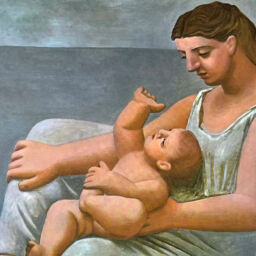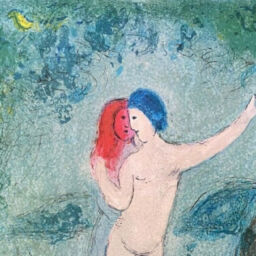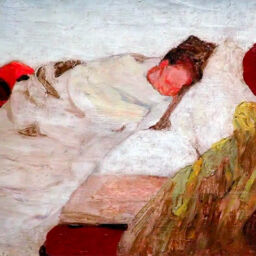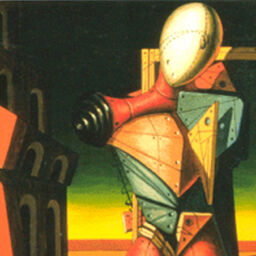
Jung’s Third Dimension
Philippe De Sainte Maresville, February 5, 2014
 Working with Myers-Briggs typology for many years now, and willing to explore more deeply all the potential of this approach, I find, like many of you, that I have no other choice than to develop a better understanding of the eight function attitudes. Even though many contemporary books, most of them in English, help a lot in getting a good grasp of the function attitudes, we reach a point where it becomes beneficial to confront all this knowledge at the source: the psychological types of C.G. Jung.
Working with Myers-Briggs typology for many years now, and willing to explore more deeply all the potential of this approach, I find, like many of you, that I have no other choice than to develop a better understanding of the eight function attitudes. Even though many contemporary books, most of them in English, help a lot in getting a good grasp of the function attitudes, we reach a point where it becomes beneficial to confront all this knowledge at the source: the psychological types of C.G. Jung.
Returning to the source brings a lot of valuable information and from this research journey, done with my colleague Philippe Beuret, we came back with a new interpretation of the ‘articulation’ of the functions. We found that Jung’s approach is, in a way, very Ti oriented (introverted thinking). The way he approaches the functions looks like a classification job, and reading Chapter X of Psychological Types, shows a logical way of splitting all functions of the psyche into eight irreducible ones.
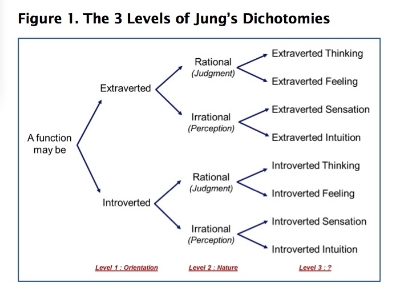 As you know, part of his approach is based on the “opposite tension” within pairs of polarities. This can therefore be viewed as a ‘binary approach’ as most of his classification works like a two-faced coin. So we have a binary approach to classification, splitting every aspect of the personality into either ‘A’ or ‘B,’ which somehow leads us to eight function attitudes, and 8 is equivalent to 2 cubed. This means that getting eight functions with a binary approach requires three levels of dichotomy, which is what Jung has almost done.
As you know, part of his approach is based on the “opposite tension” within pairs of polarities. This can therefore be viewed as a ‘binary approach’ as most of his classification works like a two-faced coin. So we have a binary approach to classification, splitting every aspect of the personality into either ‘A’ or ‘B,’ which somehow leads us to eight function attitudes, and 8 is equivalent to 2 cubed. This means that getting eight functions with a binary approach requires three levels of dichotomy, which is what Jung has almost done.
In fact Jung made it quite clear about the first two levels, which are explained in detail. However, when he applied the third dichotomous level, he never explained it, nor presented it in broad and independent perspective. The third level was always simply presented in context. In his work with psychological type, C.G. Jung started with what he sees as a primary dichotomy split, the ‘orientation of energy’ which divided psychological functions into two groups:
- on one side, functions oriented toward the external world and the object,
- on the other side, functions oriented toward the internal world and the subject.
Later, he came up with a second dichotomous split, which opposes functions based on their ‘nature’ or goal:
- on one side, “rational” functions with a judgment goal,
- on the other side, “irrational’ functions with a perception goal.
I refer to this dimension by the term Nature, and to the previous dimension as Orientation. I consider these dichotomous levels as broad and independent because they can be used from the starting point of the psyche, i.e. you can use either dichotomy to split the whole psyche into two groups of function-attitudes:
- Using the Orientation dichotomy, you can group them in extraverted vs. introverted function-attitudes —(Te/Fe/Se/Ne vs. Ti/Fi/Si/Ni)
- or using the Nature dichotomy, you can group them in rational vs. irrational function-attitudes —(Te/Fe/Ti/Fi vs. Se/Ne/Si/Ni).
Where it becomes tricky is when we consider the third dichotomous level—the third “dimension” of psychological type. C.G. Jung always presented this level in context. He clearly explained his split of the irrational functions into two opposite functions, S (Sensation) and N (Intuition), and the same for the rational functions, T (Thinking) and F (Feeling), but he never related these two splits to each other. Puzzled by this lack of a theoretical context for this third dichotomy, we investigated the possibility of links between the other two splits. Can these two splits be treated as having a broad and independent dichotomous rationale or are they just two contextual splits with no relationship to each other? In concrete terms, does S have something in common with either T or F; and does N have something in common with F or with T? If the answer to this question is ‘yes,’ then there is, indeed, a theoretical rationale for the third level of dichotomous splits that leads to the eight function-attitudes. And identifying such a link could help us better understand the function pairs (SF vs. NT or ST vs. NF). On the other hand, if there are no relationships across the first two dichotomies, then the theoretical basis for the third split remains a mystery—and thus, more open to questions, challenges, and misinterpretation.
In our research, we explored the two possibilities:
- Option A: a possible link between Sensing and Thinking, and between Intuiting and Feeling,
- Option B: a possible link between Sensing and Feeling on one side and between Intuiting and Thinking.
Both options gave us interesting results. During our exploration we got not only into the details of what the function attitudes are, as C.G. Jung describes them, but we also explored other approaches like Walter Lowen’s Dichotomies of the Mind (2006) and Karl Pribram and Katherine Benziger’s work (2006) in the neurosciences. Our detour into the neurosciences was a particularly interesting one because it gave clues relating to both options and it helped us to make up our minds in favor of option B, which we concluded to be more meaningful from both a logical and a neuroscience and evolutionary standpoint. Let’s explore both options:
Option A: S and T on one side, N and F on the other side
This is the one which is used conventionally in MBTI® literature, where the dimensions of personality are presented in tables with E – S – T – J on one side and I – N – F – P on the other side. It is also the scheme that Jung used in his book: S then N, T then F. All this is just convention and gives no clues about possible linkages between S and T or N and F.
What do Sensing and Thinking have in common? What comes to mind is that both functions provide structure. S provides a kind of sequential structure and T provides a kind of matrix structure. Both functions draw clear lines and operate in a way that can be viewed as logical processing.
On the other side, Intuiting and Feeling come with a kind of fuzziness. Things are not black and white, the lines are more blurred. Intuition goes in many directions following links as they surface in consciousness; Feeling uses a value system where the line between what is accepted or rejected is not easy to draw. These functions both seem to operate in a way that can be viewed as analogy-based processing.
It is interesting to note that in their work about functions and the brain, Pribram and Benziger tend to locate S and T on the left hemisphere which is viewed as the seat of logic and convergence; and they locate N and F on the right hemisphere which is viewed as the seat of analogy and divergence. This approach is not too far away from the notion of divergent thinking vs. convergent thinking, as articulated by Kahneman (2011) and Pinker (2005). Viewed in terms of the type model, we can see that the ST pair reinforces the logical side of operation of these types, whereas the NF pair shows a more analogical way of operating.
Beyond the conventional notation and this Convergent vs. Divergent operation mode, we didn’t find more information that argues in favor of ‘Option A’ as the explanation we were seeking.
Option B: S and F on one side, N and T on the other side
Our researches on this option led us to consider three interesting angles:
The first angle is the level of abstraction used by the function to gather or process information. It’s obvious for the Perceiving functions—it is even ‘by definition’—that Sensors perceive information in a very concrete way, whereas Intuitives perceive information in a more conceptual and abstract way. Nothing new here. When we used this same lens to explore the Judging functions, we found that these functions process information with two different levels of abstraction as well: Thinking treats information with a high level of abstraction. The T function makes judgments based on theories, law, rules, logic—all frameworks that are conceptual, resembling models of reality. Thus, Thinking refers to an abstract model of real life. Feeling treats information with a lower level of abstraction. The F function makes judgments based on values that are connected to realty, close to the field. F has a concrete connection to what your values are; even your body can tell you when you are ‘out of value.’ F needs to be close to the real world, to real life, in order to decide. In sum, you can actively live your values, whereas rules and laws remain conceptual.
The second angle relates to the neurosciences, referring again to Pribram and Benziger’s work. In addition to the classic split between the left vs. right hemispheres, our cortex can also be viewed as split between the frontal lobes vs. posterior convexities. These areas are separated by the central fissure, the location of the primary motor cortex and the somatosensory cortex. The frontal lobes are not closely connected to the sensory system, and are engaged for conceptual and complex work. Thus, they match well with the operating modes of T and N. The posterior convexities are connected to the sensory system, and therefore tend to be engaged with the concrete world. Thus, they match well with the operating modes of S and F. This difference also resonates with the Abstract vs. Concrete of the first angle.
The third angle refers to mankind’s evolution. Looking at the evolution of Homo sapiens both in terms of behavioral and brain development, we can notice that N and T appear more recently; Intuition and logic came after Sensation and values. We can relate that angle with the previous one, as evolution shows that the frontal part of the brain is the recent development, and many representations of mankind’s evolution show the ‘growth’ of the frontal lobes.

Conclusion
When presenting Jung’s functions, it became clear to us that using a three-dimensional approach gives more strength to his classification and provides more information for people to orient themselves within the eight functions. In fact, by defining clearly the third dimension, we can ‘describe’ and differentiate all functions using three qualifiers, one per dimension or dichotomy.
However, to be able to apply this three dimensional approach, we can have only one third dimension. We therefore need to determine whether option A or B is more applicable. Even if both could apply, it may be useful to choose the one that makes more sense, is easier to explain, and gives strength to the whole approach. We decided to select option B, for several reasons:
- This dimension is easier to explain (its Abstract vs. Concrete difference is easier to present and more accessible than the Divergent vs. Convergent difference of option A),
- the evolutionary angle adds strength to this dimension,
- and in option A, Divergent vs. Convergent may add confusion, as we can argue that this dichotomy could also apply to the J-P dimension in the MBTI model (J can be viewed as convergent and P as divergent).
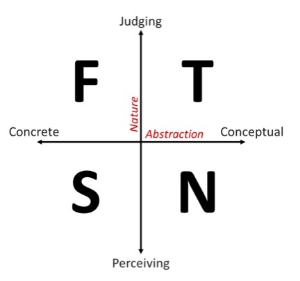 Looking only at the four fundamental functions (i.e., just the functions themselves, without an extraverted or introverted orientation, which also means looking at the functions without using the Orientation lens), we can plot them using the two remaining dimensions, Abstraction and Nature, as illustrated in the figure on the right.
Looking only at the four fundamental functions (i.e., just the functions themselves, without an extraverted or introverted orientation, which also means looking at the functions without using the Orientation lens), we can plot them using the two remaining dimensions, Abstraction and Nature, as illustrated in the figure on the right.
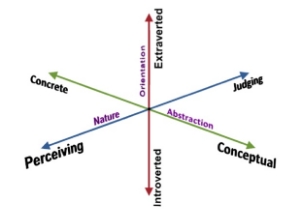 When we look at the total picture, then, Jung’s function-attitudes can be classified using three broad and global dichotomies:
When we look at the total picture, then, Jung’s function-attitudes can be classified using three broad and global dichotomies:
- Orientation (Extraverted vs. Introverted)
- Nature (Perceiving vs. Judging)
- Abstraction (Concrete vs. Conceptual)
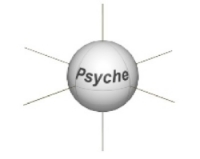 This can be summarized with a three-axes diagram:
This can be summarized with a three-axes diagram:
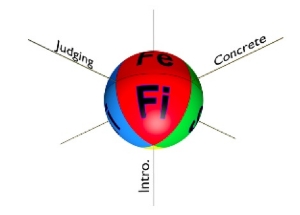 Let us now consider the psyche as a whole and represent it as a sphere. Applying the three axes delimits eight surfaces which can be viewed as the eight function-attitudes.
Let us now consider the psyche as a whole and represent it as a sphere. Applying the three axes delimits eight surfaces which can be viewed as the eight function-attitudes.
All eight function-attitudes can be identified using these three qualifiers. For example we can view introverted feeling as Judging, Concrete, and introverted, represented as shown in this animation
To conclude, I think that considering this Abstraction level as a third dimension of the functions-attitude classification or model, and therefore using it as a new ‘lens’ for looking at types, gives us valuable information on how types deal with complexity. It can help practitioners understand how Intuition and Thinking reinforce each other in seeking complexity. With this lens we can see that NT types are very comfortable with complexity, and may even be so drawn to it that they have difficulty “keeping it simple” or “down to earth.” With this pair of preferences they would be wholly and unabatedly interested in abstraction and concepts.
Sensing and Feeling, on the other hand, reinforce each other by seeking simplicity, a will to make things simpler and practical. They may also push others to express things in a simple and practical way. With this pair of preferences they would be ‘all about’ concreteness, simplification, and ‘closeness to the field’ of reality.
This also shows how SF and NT types are far apart in terms of operating mode and may have more difficulty interacting and understanding each other than has already been recognized, to the extent of feeling that they live in two different worlds.
Looking at the two other combinations shows how a mix of concrete and conceptual functions (ST or NF) gives such types the capability to bridge both worlds. One (ST) can be seen as upward-moving from concrete perception to a conceptual judging. These types have the capability to create models and classify the real and concrete world. On the other side, NF can be seen as downward-moving from a conceptual perception to a concrete judging level. These types have the capability to connect concept with real life, to make the ideal come true.
The ST and NF may feel very different; but rather than having difficulties in understanding each other, they contrast more in their purpose than in their approaches to representation of the world.
As a bonus, using the sphere representation, we can illustrate the individuation process, as moving from an undifferentiated psyche represented by the grey sphere on the left toward a psyche with a clear differentiation of all functions represented by the colorful sphere on the right.
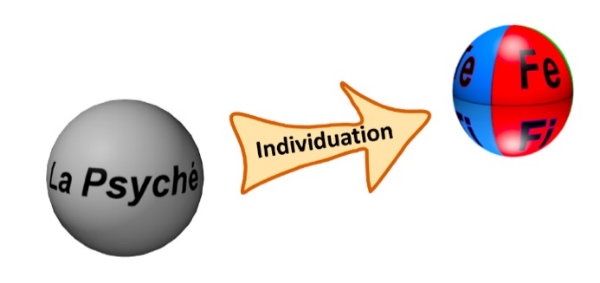
References
Benziger, K. (2006). Thriving in mind. Carbondale, IL: KBA, LCC.
Jung, C. G. (1993). Types psychologiques. Geneva, Switzerland: Georg Editeur S.A.
Kahneman, D. (2011). Thinking, fast and slow. New York, NY USA: Farrar, Straus & Giroux.
Lowen, W. (2006). Personality types: A systems sciences explanation. North Charleston, SC: BookSurge Publishing.
Pinker, S. (2005). Comprendre la nature humaine. Paris, France: Odile Jacob.
Header Image
Max Weber, “Interior of the Fourth Dimension” (1913) – Courtesy of the National Gallery of Art, Washington





